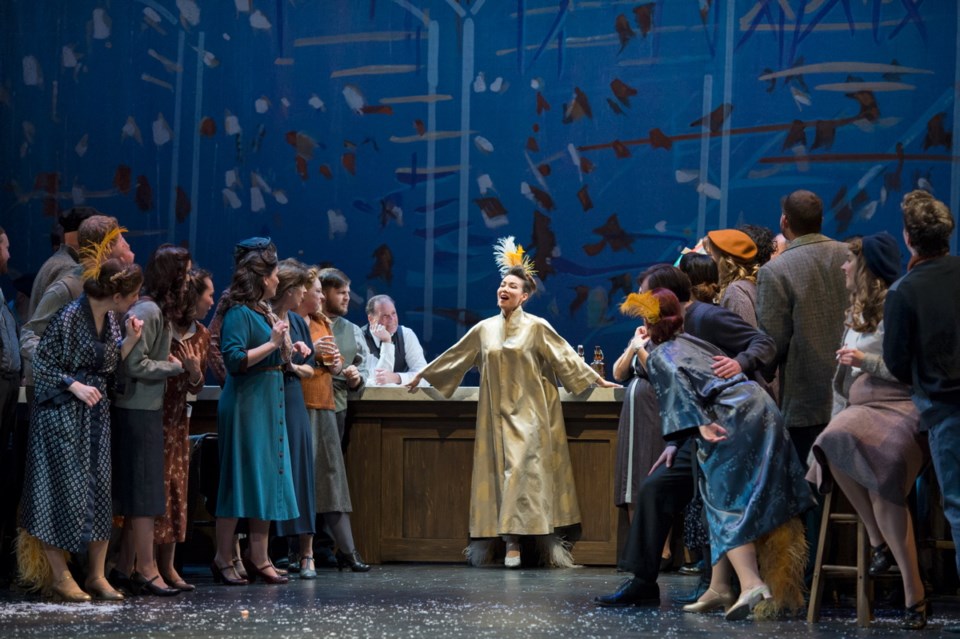If there ever was a greatest hit in opera, La bohème is surely it. Puccini’s 1896 creation, an audience favourite, is in constant rotation — the Metropolitan Opera has performed it more than 1,200 times.
For the novice, La bohème — now revived by Pacific Opera Victoria — is an easy and entertaining introduction to the art form. It’s an accessible, archetypal opera chockful of the good stuff: jealousy, flirtations, declarations of love, festive crowd scenes, penniless artists in garrets, heroines dying romantic deaths. And Puccini’s beautifully melodic arias still sound as dewy and fresh as Paris in May.
POV’s La bohème is worth seeking out. Director Maria Lamont chose a more-or-less traditional approach, yet still has sparky fun with it. The capable cast is young and attractive. On Thursday night, some singing was very fine. Those who prefer their opera to be over-the-top melodramatic might find this one a touch muted in places. Yet overall, most will appreciate the wit, style and panache presented by Lamont and company.
The setting — Paris at Christmas time — is shifted from the 19th century to what might be the early 1960s (although it could be the 1940s or 1950s). Consumptive Mimi, well-sung by soprano Lucia Cesaroni, sports a smart pencil skirt. Wonderfully sketched backdrops of Parisian rooftops in blue and grey suggest mid-century film sets.
Lamont gives La bohème its full due, yet there are times when the show winks at us in 21st-century fashion. After Musetta spars with Marcello in the Café Momus scene, the pair collide in a clowny, rapturous embrace with the vixen scaling her lover like a pole-dancer — a joke repeated later in the show. (On Thursday, it was announced that baritone Brett Polegato, who plays Marcello, was suffering from flu. His performance was commendable as he both sang and acted well.)
For the most part, Pacific Opera Victoria is serving a classic La bohème that will not disappoint the traditionalist. The opera begins with the four amigos — painter Marcello, poet Rodolfo (tenor Jason Slayden), musician Schaunard (baritone Andrew Love) and philosopher king Colline (bass-baritone Stephen Hegedus) — gathering for a Christmas Eve feast complete with wine and cigars. When the landlord (tenor J. Patrick Raftery) comes for the rent, he’s plied with booze, tied in a long scarf, then sent packing.
Mimi and Rodolfo then meet, and the hero, kneeling, dispatches Your Tiny Hand is Frozen, one of opera’s most famous songs. Slayden, a handsome fellow with a floppy Hugh Grant haircut, sang this with a pleasant, light tenor that served him well throughout.
At times, both in physicality and in song, Slayden seemed to pull his punches. Rodolfo’s exclamation when his lover dies — “Mimi!” — is surely one of the most dramatic in opera, yet on this night it seemed curiously muted. Elsewhere, Slayden did convince, especially during the anguished scene when he reveals to Marcello that Mimi is indeed dying.
Cesaroni proves herself both a fine singer and actor. Her Mimi (or at least, her healthy Mimi) was sinuous and seductive. Cesaroni has an expressive face and a gift for projecting movement beyond the footlights. Her rendition of They Call Me Mimi revealed a voice that is smooth, lush and velvety.
Another standout is Sharleen Joynt as Musetta. POV regulars will remember the coloratura soprano as Queen of the Night in last year’s Magic Flute. Joynt’s projection is admirable. In La bohème, some singers were occasionally overwhelmed by the Victoria Symphony Orchestra, which is curious, since Giuseppe Pietraroia kept the volume in check.
That was never the case with clear-timbred Joynt, who especially impressed with As through the streets I wander. For this, she is spectacularly outfitted as a glittery showgirl in front of a lit Eiffel Tower, supported by waiters as in a vintage Hollywood movie. This showy scene ends satisfyingly with a cascade of silver snowflakes.
There’s no weak link in this solid cast. Hegedus, who moves well, impressed with his rendition of Colline’s moving little song about parting with his overcoat.
Choreographer Jessica Hickman has created entertaining dances for large ensemble sections. There’s a funny routine in which the Bohos pay homage to the minuet, the fandango and the quadrille. And there is a charming crowd scene with members of the Victoria Children’s Choir waving French flags.
La bohème ends in a way I’ve always found abrupt. Mimi dies, the curtain drops. Lamont chooses to work with this, underscoring the drama by suddenly raising the backdrop, revealing the theatre’s brick wall in a manner both stark and brutal.
La bohème continues at the Royal Theatre today, Feb. 21, 23 and 25.



